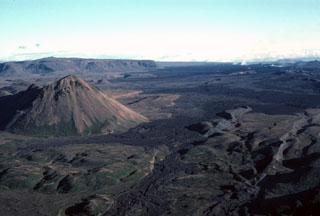Report on Krafla (Iceland) — January 1977
Natural Science Event Bulletin, vol. 2, no. 1 (January 1977)
Managing Editor: David Squires.
Krafla (Iceland) Details of seismicity and deformation associated with 20 January magma intrusion
Please cite this report as:
Global Volcanism Program, 1977. Report on Krafla (Iceland) (Squires, D., ed.). Natural Science Event Bulletin, 2:1. Smithsonian Institution. https://doi.org/10.5479/si.GVP.NSEB197701-373080
Krafla
Iceland
65.715°N, 16.728°W; summit elev. 800 m
All times are local (unless otherwise noted)
On 20 January a remarkable intrusion of magma was documented in N Iceland, one of a series of similar events during the last year [September and October/November] that are being carefully studied by virtually all geoscientists in Iceland. For a detailed account see Björnsson and others (1977).
On 20 December 1975, intense earthquake activity began in Krafla caldera, 10 km N of Lake Mývatn in N Iceland. Within half an hour a volcanic eruption had occurred, producing a minor lava flow (1:3). During the following 2 hours, earthquake activity propagated along 40 km of a fissure system N of the caldera. Horizontal ground movement of the order of 1 m and vertical displacement of the same magnitude were recorded within the fissure zone. Within Krafla caldera, a subsidence of 2.5 m was measured by precision levelling relative to Lake Mývatn. A high level of earthquake activity (maximum magnitude 6.3) continued within and N of Krafla caldera until mid-February. In March, significant inflation was recorded within Krafla caldera, and drastic chemical changes were noted in both drillhole and fumarole emissions from the caldera's geothermal field. While inflation continued at a steady rate, earthquake activity remained low and constant until July, when the number of seismic events started to increase. This activity culminated at the end of September, with rapid deflation of the Krafla area, accompanied by harmonic tremor and migration of hypocenters 20 km northward along the fissure system.
Seismic activity discontinued with this deflation event, but inflation started again immediately. When the ground level reached the same position as before the deflation event, seismic activity rapidly increased again. This cycle culminated, at the end of October, with another (and much greater) deflation event, accompanied by the same seismic behavior as before.
As with the two earlier deflations, inflation started immediately, and at the same rate as before. This rate, when combined with the measured amount of deflation, enabled geologists to estimate exactly the timing of the third event, which started shortly after midnight on 20 January, 1977. Tilt measurements indicated a deflation of the order of 100 µrad during 12 hours, accompanied by continuous harmonic tremor and frequent earthquakes that migrated in the same direction as on previous occasions. This deflation, however, lasted for less than 24 hours (in contrast to five days for the September and two days for the October deflation) and only 12 km of the fissure system was active this time. Surface fissures to 40 cm in width were measured in the snow, and fuming (water only) was observed along the active zone. After deflation, surface geothermal activity was limited to the end of the 12 km fissure system farthest from Krafla caldera.
The last major eruption in the area, the Mývatn fires, occurred in 1724-29. The activity culminated during the last two years of the 5-year period with voluminous outpouring of basaltic lava covering 35 km2. Contemporary descriptions of these events indicate some similarities with the current behavior at Krafla. Using the same "inflation" approach they used successfully in November, Icelandic geologists are predicting the next deflation event on 20 March 1977.
Geological Summary. The Krafla volcanic system in the Northern Volcanic Zone (NVZ) of Iceland is about 100 km long, consisting of a fissure swarm and a central volcano with a 7 x 9 km caldera formed about 110,000 years ago that deposited a rhyolitic welded tuff. It has been moderately active in the Holocene, over three distinct eruptive periods; the current one has lasted about 2,800 years with six volcano-tectonic episodes, each with one or more basaltic fissure eruptions. Lava volumes (DRE) have been in the 0.1-1 km3 range. The Hverfjall and Ludent tuff rings east of Myvatn were erupted along the fissure system. Myvatn lake formed during the eruption of the older Laxarhraun lava flow from the Ketildyngja shield volcano of the Fremrinamur volcanic system about 3,800 years before present (BP); The present Myvatn lake is constrained by the roughly 2,000 years BP younger Laxarhraun lava flow from the Krafla volcanic system. The abundant pseudocraters that form a prominent part of the Myvatn landscape were created when the younger Laxarhraun lava flow entered the lake. The last eruption took place in 1975-1984 CE when nine small basaltic fissure eruptions produced 0.25 km3 of lava.
Information Contacts: G. Sigvaldason, NVI.

